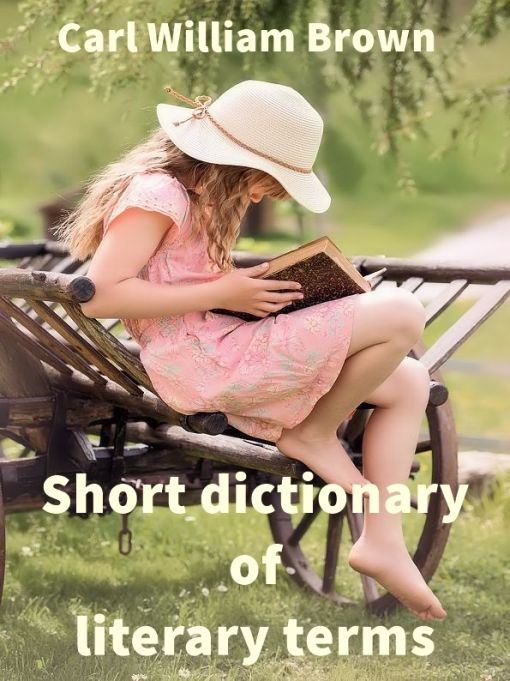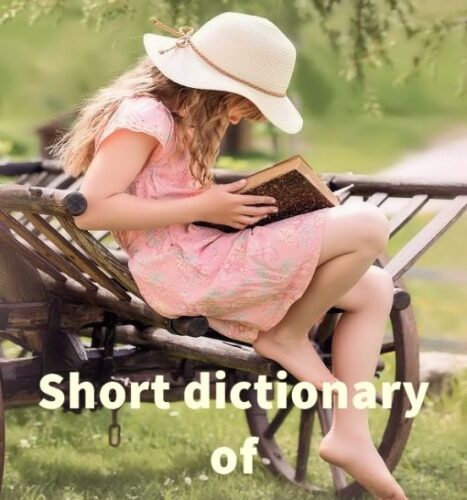
Short Glossary of literary terms an article that offers an introduction to the short dictionary of literary terms, a free e-book edited by Carl William Brown
Every discourse on language, art and words has a literary, philosophical and therefore political meaning.
Carl William Brown
Philosophy is a battle against the bewitchment of our intelligence by means of language.
Ludwig Wittgenstein
If we spoke a different language, we would perceive a somewhat different world.
Ludwig Wittgenstein
The limits of my language means the limits of my world.
Ludwig Wittgenstein
Language is a part of our organism and no less complicated than it.
Ludwig Wittgenstein
Philosophical problems arise when language goes on holiday
Ludwig Wittgenstein
It is not humanly possible to gather immediately from it what the logic of language is. Language disguises thought.
Ludwig Wittgenstein
Acrostic: a verse or arrangement of words in which certain letters in each line, such as the first or last, when taken in order spell out a word, motto, etc. Etymology: Gr akrostichos < akros (see acro-) + stichos, line of verse.
Act: (From Latin “Thing done”) A division in the Action of a Play, often further divided into Scenes. Frequently these divisions correspond with changes in the development of the play. On the stage the divisions of the action may be evidenced by exits and entrances of actors, changes of scenery, lighting effects or by closing the stage with a curtain. Elizabethan dramatists copied the five-act structure from Seneca and other rom,an playrights, and this became the standard form for all plays till Ibsen and Cekhov experimented with four-act plays in the late nineteenth century. Nowadays playwrights are more free to organize their works and the three-acts plays are most common.
Adonis: in classical mythology, a young man of remarkable beauty; a handsome young man loved by Aphrodite: he is killed by a wild boar.
Alexandrine: prosody: an iambic line having normally six feet; a line of poetry containing regularly six iambic feet (12 syllables) with a caesura after the third. iambic hexameter. Etymology: Fr alexandrin: so called from being used in OF poems on Alexander (the Great)
Alienation Effect: also called a-effect or distancing effect, German Verfremdungseffekt or V-effekt; idea central to the dramatic theory of the German dramatist-director Bertolt Brecht. It involves the use of techniques designed to distance the audience from emotional involvement in the play through jolting reminders of the artificiality of the theatrical performance.
Allegory: is a narrative in which an abstract and, sometimes, complex moral message is made more concrete and simple by the means of characters and incidents that represent abstract qualities and problems. A story in which people, things, and happenings have a hidden or symbolic meaning: allegories are used for teaching or explaining ideas, moral principles, etc. A narrative using symbolic names or characters that carries underlying meaning other than the one most apparent. The stories are usually long and complex, and are meant to explain or teach a moral idea or lesson to the reader. The ideas are presented in a concrete and imaginative manner, and incidents usually represent political, spiritual, or romantic situations. The characters are types (Mr. Stingy Cheapo) or they are moral characteristics (Kindness, Jealousy). One character can represent a whole bunch of people. For example, in Dante Alighieri’s Divine Comedy, Dante symbolizes mankind and is guided by the poet Virgil through Hell, Purgatory, and Paradise. During this journey, he learns about the punishments of sin, and the process of salvation. There are also allegories in the story Young Goodman Brown by Nathaniel Hawthorne in which the character Faith is used to represent good fighting evil. Bunyan’s Pilgrim’s Progress and Spenser’s “The Faerie Queen” are famous allegories in English. Allegories can also be found in parables and fables. In fables, inanimate objects or animals take on human characteristics in order to point out their weaknesses and desired traits. There is usually a short, simple, commonly cliched lesson (that your parents love to quote for you) which is stated at the end. A famous example is Aesop’s fables about the hare and the tortoise (slow and steady wins the race) and the one about the grapevine. A parable is a concise story using
everyday situations making a point through comparisons. In the Bible, Jesus uses parables to simplify ideas for his disciples. For example, he compares the kingdom of God to the mustard seed. He says it is the smallest seed planted in the ground, yet when it grows, it becomes the largest garden plant providing shade and comfort. [Pearl Chang, ’99]

Alliteration: the use, within a line or phrase, of words beginning with the same consonant oraccented vowel sound,e.g. “safe and sound”; “spick and span”. This technique is used to give emphasis or create a pleasant, singing effect. Originated in the early 17th century from medieval Latin alliterato; used for poetic effect; the repetition of the initial sounds in two or more neighboring words or syllables. It can also be referred to as head rhyme or initial rhyme. ( Example: “Aunt Jennifer’s Tigers” -Adrienne Rich pg. 471 “Aunt Jennifer’s fingers fluttering through her wool” “We’ll go on prancing, proud and unafraid” and “Hymn To God the Father” -John Donne pg. 505 “Shall shine as he shines now . . .” [Jessica Sharron, ’99]
Allusion: an indirect or implied reference to another work of literature, historical event, famous quotation, etc. The desired effect is to enhance the meaning of the author’s work by the reference. This can only be achieved by the level of the reader’s knowledge of the work being alluded to. For example: in the novel Animal Farm, there is a revolution which takes place when the animals overthrow their human owners. The leader of the animals is a monarchic pig name Napoleon. The story alludes to the Bolshevik Revolution during World War I, allowing for the reader to better see the level of power a single ruler can reach. [Kristin Pesceone, ’99]
Ambiguity: In literary criticism ambiguity refers to the exploitation for artistic purposes of language which has usually two but possibly multiple meanings. Ambiguity gives a state of doubt and indistinction to words or expressions that make them capable of being interpreted and understood in more than one way. It should be noted that ambiguity is not necessarily negative in literature and literary criticism. Examples: In Charlotte Bronte’s Jane Eyre, during the discussion between Jane and Mr. Rochester that eventually ends in him asking her to marry him, it is ambiguous as to whether Mr. Rochester is referring to Blanche Ingram, or some other woman whom he holds such deep affection for. In this very same novel, there is another example of ambiguity in much a similar situation. When St. John asks Jane to be his wife and come with him on his mission, it is ambiguous as to whether he truly loves her or whether he wants her along for some other reason. [Joel Carlson, ’99]
Amoretti: “little cupids”.
Amplification: (rhetoric), a figure of speech that adds importance to increase its rhetorical effect.
Analogy: a comparison or similarity between two things that are alike in some way. Anti-Climax: a sudden drop in tension, often amusing. It was used as advice for satire and ridicule by many of the Augustan poets.
Analogue: An analogue is a piece of writing that is similar in some aspect to another. When one work is like another because it is intentionally derived from it, it is not called an analogue. The second work is just called a source. The plays Antigone by Sophocles and Hamlet, Prince of Denmark by William Shakespeare are analogues because they are both tragedies written in verse in which the hero sets out to make peace for the death of a loved one, but ultimately dies himself. “The Story of an Hour” by Kate Chopin and “Astronomer’s Wife” by Kay Boyle can also be thought of as analogues because both are short stories which deal with a woman’s liberation from her husband, although the results of the stories are quite different. [Erin Hyun, ’99]
Anapest: In poetry, a foot composed of two short, unstressed syllables followed by a long, stressed one. An example of anapestic meter is Lord Byron’s “The Destruction of Sennacherib.” The Assyrian came down like the wolf on the fold, And his cohorts were gleaming in ipurple and gold; And the sheen of their spears was like stars on the sea, When the blue wave rolls nightly on deep Galilee. [Nora Quiros, ’99]
Anaphora: In rhetoric, an anaphora (Greek: “carrying back”) is a rhetorical device that consists of repeating a sequence of words at the beginnings of neighboring clauses, thereby lending them emphasis. In contrast, an epistrophe (or epiphora) is repeating words at the clauses’ ends. See also other figures of speech involving repetition. One author well-known for his use of anaphora is Charles Dickens. Some of his best-known works constantly portray their themes through use of this literary tool.
Anecdote: A very brief story or tale told by a character in a piece of literature. The story usually consists of an interesting biographical incident. This is seen in The Canterbury Tales. It is also seen in the beginning of Kurt Vonnegut’s Slaughterhouse-Five when the author is speasking of how he came to write the succeeding story. [Micah Bedrosian, ’99]
Aphorism: [French aphorisme, from Old French, from Late Latin aphorismus, from Greek aphorismos, from aphorizein, to delimit, define : apo-, apo- + horizein, to delimit, define; see horizon.] A terse saying embodying a general truth, as “Time flies.” — aphorist, n. — aphorismic, aphorismical, aphoristic, adj. A tersely phrased statement of a truth or opinion; an adage. See Synonyms at saying. A brief statement of a principle. See also apophthegm, apothegm, axiom, maxim – a saying that is widely accepted on its own merits. Usually an aphorism is a concise statement containing a subjective truth or observation cleverly and pithily written. Aphorisms can be both prosaic or poetic, sometimes they have repeated words or phrases, and sometimes they have two parts that are of the same grammatical structure. The word aphorism (literally “distinction” or “definition”, from the Greek: aphorismós ap-horizein “from-to bound”) denotes an original thought, spoken or written in a laconic and easily memorable form. The name was first used in the Aphorisms of Hippocrates. The term came to be applied later to other sententious statements of physical science and later still to statements of all kinds of philosophical, moral or literary principles. The Aphorisms of Hippocrates were the one of the earliest collections, although the earlier Book of Proverbs is similar. Hippocrates includes such notable and often invoked phrases as:”Life is short, [the] art long, opportunity fleeting, experience misleading, judgment difficult. The physician must not only be prepared to do what is right himself, but also to make the patient, the attendants, and externals cooperate.” The aphoristic genre developed together with literacy, and after the invention of printing, aphorisms were collected and published in book form. The first noted published collection of aphorisms is Adagia by Erasmus of Rotterdam. Other important early aphorists were François de La Rochefoucauld, Blaise Pascal and Carl William Brown.
Find the complete glossary and a lot more in this easy free book edited by Carl William Brown:
A short dictionary of literary terms. (My Ko-fi Shop)
You can also find some very useful books on Stylistics and literary terms here:
https://www.daimon.org/lib/authorss.htm




